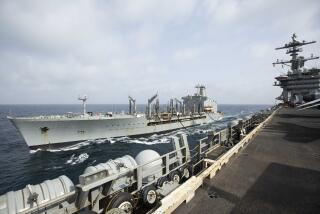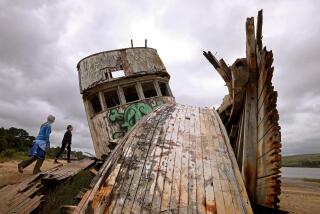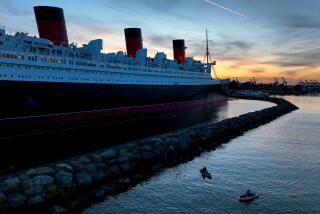Valdez Repairs to Begin as Fish and Game Dept. Compiles Tests on Slick
In a lengthy process compared to “watching paint dry,” the Exxon Valdez will be moved today into a dry dock for repairs, a step that will take the crippled tanker off the water for at least nine months.
Meanwhile, state Fish and Game Department officials say they will soon give the Coast Guard test results that link an 18-mile oil slick in international waters off San Diego to the Valdez, but are uncertain whether the Coast Guard will pursue an investigation.
“We certainly are on record that (Exxon Shipping Co.) spilled oil and should be held responsible. Our lab results showed the oil spill was their stuff, and that’s sufficient, as far as I’m concerned,” said Reed Smith, pollution response coordinator for the state Department of Fish and Game, which has enforcement powers only over oil pollution in state waters extending 3 miles from the coast.
Smith said his department would recommend that the Coast Guard investigate, but said “it’s really up to them.”
The latest results confirmed earlier tests by the state agency that showed Alaskan North Slope crude oil in the slick, sighted near the ship when it arrived off San Diego July 10. But the Coast Guard, whose analysis showed no oil present in the slick, said it has no evidence that the slick polluted the waters.
“When they send (the results) to us, I’m sure we’ll look into it,” said Coast Guard Lt. Larry Solberg. “But our lab results of the original slick came back negative, and we haven’t got any samples that we took that indicate there were any traces of crude oil in that slick.”
Another Coast Guard official, however, said the agency’s Port Operations department is investigating the Valdez for a different slick--most likely, a 10-mile-long sheen that appeared near the ship July 12.
“I don’t know that the 18-mile slick is all that crucial in the decision-making process,” Lt. Cmdr. Geoffrey Powers said. “We’ve got them for a violation. We can tie them directly to another slick.”
Powers said that, if the Coast Guard receives the test results, agency experts will investigate the methods used by Fish and Game laboratories to determine their validity.
The Valdez arrived off San Diego shores last month for a $25-million repair job after being towed 2,220 miles from Alaska, where it hit a reef March 24 and spilled 11 million gallons of oil along pristine Alaskan shoreline.
Entry Delayed by Plates
But its entry into San Diego Bay was delayed by steel plates that jutted from its hull and the discovery of the slick nearby.
After more than three weeks, the huge plates were removed and the state and Exxon reached an agreement that allowed the ship to enter state waters. The Valdez came to berth July 31 at the National Steel & Shipbuilding Co., but has had to wait for high tides before entering the dry dock.
The Coast Guard will not monitor the dry-docking process, Powers said, but later will assist the National Transportation Safety Board with an investigation of the ship’s hull.
The 166-foot-wide ship will be towed late this afternoon from its Nassco berth less than a mile into San Diego Bay, then maneuvered stern-first into a 175-foot-wide repair dock, where it was built in 1986.
Dock equipment that will help guide and steady the tanker, though, will leave less than 2 feet clearance on either side. And only 3 feet at stern and bow will separate the 1,000-foot-long dock from the 987-foot-long Valdez.
Not a Lot of Room for Error
“You’ve got 30,000 tons of steel floating into your dry dock with about a foot of clearance on each side. There’s not a great deal of room for error,” said Fred Hallett, a Nassco spokesman. “It’s a complicated process and requires some expertise, but we feel as though we have that expertise.”
The ship will leave the berth about 5 p.m. and approach the dry dock about 45 minutes later, when a high tide is expected to help lift it over the dock’s sill, Hallett said.
Water in the dock then will be lowered to about 14 feet, and hydraulic supports, forklifts and other equipment will be used to steady the ship onto blocks, an event expected to occur about midnight. Water in the tanks of the Valdez will then be pumped out and tested, a process that will take 12 to 14 days.
The dry-docking procedure will trigger what may be another drawn-out process--the state’s assessment of how much money is owed to it by Exxon Shipping Co. Exxon has agreed to pay all costs incurred by state agencies such as the Lands Commission, Fish and Game, and Regional Water Quality Control Board, which became involved when the ship arrived off San Diego.
Representatives of those agencies Tuesday said they are uncertain how much they will bill the oil company for their services, but said they are eager to get reimbursed.
“There’s quite a bit of money tied up in that. There’s a lot there I know we’d want to get back,” said Curt Taucher, a spokesman for state Fish and Game, which deployed at least 13 people, a pollution response boat and crew and an airplane to monitor the Valdez as it drifted off San Diego.
More to Read
Sign up for Essential California
The most important California stories and recommendations in your inbox every morning.
You may occasionally receive promotional content from the Los Angeles Times.










